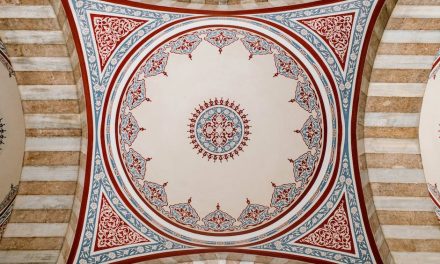Table of Contents
- Introduction
- The Role of Leadership in Arab Literature: Exploring the portrayal of leaders in traditional and contemporary Arab literary works
- Leadership Archetypes in Arab Literature: Analyzing the different types of leaders depicted in Arab literary texts, from mythical figures to modern-day heroes
- Leadership Challenges in Arab Literature: Examining the obstacles and dilemmas faced by leaders in Arab literary works, and their impact on the overall narrative
- Leadership and Social Change in Arab Literature: Investigating how leaders in Arab literature contribute to societal transformation and the portrayal of leadership as a catalyst for progress
- Q&A
- Conclusion
Unveiling the Essence of Arab Literature: From Mythical Tales to Contemporary Narratives
Introduction
Leadership in Arab Literature: From Fabled Genies to Modern Realities explores the portrayal and evolution of leadership in Arab literature throughout history. From ancient tales of genies and mythical figures to contemporary narratives reflecting the complexities of modern society, this study delves into the various representations of leadership in Arab literary works. By examining the cultural, social, and political contexts in which these texts were written, this exploration sheds light on the changing perceptions and expectations of leaders in Arab literature over time.
The Role of Leadership in Arab Literature: Exploring the portrayal of leaders in traditional and contemporary Arab literary works

Leadership is a concept that has been explored and celebrated in literature throughout history. In Arab literature, the portrayal of leaders has evolved over time, reflecting the changing realities of the Arab world. From fabled genies to modern realities, Arab literature offers a rich tapestry of leadership narratives that shed light on the complexities and challenges faced by leaders in the region.
Traditional Arab literature often depicted leaders as larger-than-life figures, endowed with supernatural powers and wisdom. One of the most famous examples of this portrayal is the character of the genie in “One Thousand and One Nights.” Genies were often depicted as powerful beings who could grant wishes and possess immense knowledge. This portrayal of leaders as all-knowing and all-powerful reflects the reverence and awe that Arab societies traditionally held for their rulers.
However, as Arab societies underwent significant political and social transformations in the modern era, the portrayal of leaders in literature also changed. Contemporary Arab literature reflects a more nuanced and critical perspective on leadership, exploring the complexities and challenges faced by leaders in the region. This shift can be attributed to the increasing democratization and demands for accountability in Arab societies.
In contemporary Arab literature, leaders are often portrayed as flawed and human, grappling with the weight of their responsibilities and the expectations of their people. They are no longer depicted as infallible genies, but as individuals who must navigate complex political landscapes and make difficult decisions. This shift in portrayal reflects a growing awareness of the complexities of leadership and a desire to explore the human side of those in power.
One example of this shift can be seen in the works of renowned Egyptian author Naguib Mahfouz. In his novel “The Cairo Trilogy,” Mahfouz explores the life of a middle-class Egyptian family against the backdrop of political and social changes in Egypt. The character of Ahmad Abd al-Jawad, the patriarch of the family, is portrayed as a flawed leader who struggles to balance his traditional values with the changing realities of Egyptian society. Through his portrayal of Ahmad, Mahfouz highlights the challenges faced by leaders in navigating the complexities of a changing world.
Another example of the evolving portrayal of leaders in Arab literature can be found in the works of Lebanese author Elias Khoury. In his novel “Gate of the Sun,” Khoury explores the Palestinian struggle for independence through the eyes of a Palestinian doctor. The novel portrays leaders as individuals who must make difficult choices and sacrifices for the greater good of their people. Khoury’s portrayal of leaders reflects the realities of the Palestinian struggle and the challenges faced by those in positions of power.
In conclusion, the portrayal of leaders in Arab literature has evolved over time, reflecting the changing realities of the Arab world. From the fabled genies of traditional literature to the complex and flawed leaders of contemporary works, Arab literature offers a diverse and nuanced exploration of leadership. Through their portrayal of leaders, Arab authors shed light on the complexities and challenges faced by those in positions of power, offering valuable insights into the region’s history and contemporary realities.
Leadership Archetypes in Arab Literature: Analyzing the different types of leaders depicted in Arab literary texts, from mythical figures to modern-day heroes
Leadership in Arab Literature: From Fabled Genies to Modern Realities
Leadership is a timeless concept that has been explored and celebrated in various forms of literature throughout history. Arab literature, in particular, offers a rich tapestry of leadership archetypes that range from mythical figures to modern-day heroes. By analyzing these different types of leaders depicted in Arab literary texts, we can gain valuable insights into the evolving perceptions and expectations of leadership in Arab society.
One of the most iconic and enduring leadership archetypes in Arab literature is the fabled genie. Genies, or jinn, are supernatural beings often depicted as powerful and wise leaders. They possess the ability to grant wishes and are often portrayed as guardians or protectors. In tales such as “Aladdin and the Magic Lamp,” the genie serves as a symbol of power and authority, embodying the qualities of a benevolent leader who uses their abilities for the greater good.
Moving beyond the realm of mythology, Arab literature also presents us with leaders who navigate the complexities of modern realities. These leaders are often portrayed as individuals who rise to the occasion, displaying courage, resilience, and a deep sense of responsibility. In works such as “The Yacoubian Building” by Alaa Al Aswany, we encounter characters who embody the struggles and aspirations of contemporary Arab society. These leaders grapple with issues such as corruption, social inequality, and political oppression, striving to bring about positive change in their communities.
Another prominent leadership archetype in Arab literature is the wise and just ruler. This archetype can be traced back to ancient Arab poetry and is exemplified by figures such as Harun al-Rashid, the legendary Abbasid caliph. In tales like “One Thousand and One Nights,” Harun al-Rashid is depicted as a fair and wise leader who listens to the grievances of his subjects and dispenses justice accordingly. This archetype reflects the idealized vision of leadership in Arab society, emphasizing the importance of wisdom, fairness, and empathy.
However, Arab literature also explores the darker side of leadership, highlighting the potential for abuse of power and the consequences of unchecked authority. In works such as “Season of Migration to the North” by Tayeb Salih, we encounter leaders who exploit their positions for personal gain, perpetuating a cycle of oppression and violence. These characters serve as cautionary tales, reminding us of the dangers of unchecked authority and the need for ethical leadership.
As Arab literature continues to evolve, so too do its depictions of leadership. Modern Arab authors are increasingly exploring complex and nuanced portrayals of leaders who grapple with the challenges of a rapidly changing world. These leaders are often confronted with issues such as globalization, cultural identity, and the clash between tradition and progress. Through their narratives, Arab authors invite readers to reflect on the qualities and values that define effective leadership in the contemporary Arab context.
In conclusion, leadership archetypes in Arab literature offer a fascinating glimpse into the evolving perceptions and expectations of leadership in Arab society. From the fabled genies of mythology to the modern-day heroes navigating complex realities, these literary depictions provide valuable insights into the qualities, challenges, and responsibilities associated with leadership. By studying these archetypes, we can gain a deeper understanding of the cultural, social, and political dynamics that shape leadership in the Arab world.
Leadership Challenges in Arab Literature: Examining the obstacles and dilemmas faced by leaders in Arab literary works, and their impact on the overall narrative
Leadership Challenges in Arab Literature: Examining the obstacles and dilemmas faced by leaders in Arab literary works, and their impact on the overall narrative.
Leadership is a recurring theme in Arab literature, reflecting the rich cultural heritage and historical context of the Arab world. From ancient fables to modern novels, Arab literature offers a unique perspective on the challenges and dilemmas faced by leaders. These literary works not only provide insight into the complexities of leadership but also shed light on the broader social and political realities of the Arab world.
One of the most iconic figures in Arab literature is the genie, a supernatural being with immense power and wisdom. Genies often serve as advisors to leaders, offering guidance and assistance in times of need. However, their presence also highlights the inherent challenges of leadership. Genies, like leaders, are bound by certain limitations and must navigate the delicate balance between power and responsibility.
In the famous collection of stories known as “One Thousand and One Nights,” the character of Aladdin encounters a genie who grants him three wishes. While Aladdin initially uses his wishes for personal gain, he eventually learns the importance of using his power for the greater good. This narrative reflects the moral dilemma faced by leaders, who must make difficult decisions that impact the lives of their people.
Another prominent theme in Arab literature is the struggle for power and authority. Many Arab literary works explore the dynamics of leadership within familial and societal structures. In Naguib Mahfouz’s novel “Palace Walk,” for example, the protagonist, Al-Sayyid Ahmad, is a patriarch who exerts control over his family. However, his authoritarian leadership style leads to resentment and rebellion among his children. This portrayal highlights the challenges of maintaining authority while also fostering a sense of unity and respect.
Leadership in Arab literature is not limited to fictional narratives. Many Arab authors draw inspiration from real-life leaders and historical events. For instance, the works of Egyptian author Tawfiq al-Hakim often explore the complexities of political leadership in the Arab world. In his play “The Sultan’s Dilemma,” al-Hakim delves into the challenges faced by a ruler who must balance the demands of his people with the pressures of foreign powers. This examination of leadership in a political context reflects the realities faced by Arab leaders throughout history.
Arab literature also offers a critique of leadership and its impact on society. In his novel “Season of Migration to the North,” Sudanese author Tayeb Salih explores the consequences of blind obedience to authority. The protagonist, Mustafa Sa’eed, is a charismatic leader who captivates those around him. However, his leadership ultimately leads to destruction and tragedy. This cautionary tale serves as a reminder of the dangers of unchecked power and the importance of ethical leadership.
In conclusion, leadership challenges in Arab literature provide a nuanced understanding of the complexities and dilemmas faced by leaders in the Arab world. From fabled genies to modern realities, Arab literary works offer valuable insights into the dynamics of power, authority, and responsibility. These narratives not only entertain but also provoke thought and reflection on the broader social and political realities of the Arab world. By examining the obstacles faced by leaders in Arab literature, we can gain a deeper understanding of the challenges faced by leaders in the real world and strive for more effective and ethical leadership.
Leadership and Social Change in Arab Literature: Investigating how leaders in Arab literature contribute to societal transformation and the portrayal of leadership as a catalyst for progress
Leadership in Arab Literature: From Fabled Genies to Modern Realities
Leadership plays a crucial role in shaping societies and driving progress. In Arab literature, the portrayal of leaders has evolved over time, reflecting the changing realities of the Arab world. From fabled genies to modern-day heroes, Arab literature offers a rich tapestry of leadership narratives that shed light on the complex relationship between leaders and societal transformation.
One of the earliest examples of leadership in Arab literature can be found in the tales of Arabian Nights. These stories, set in a mythical world of genies and magic, often feature powerful leaders who possess extraordinary abilities. These leaders, such as Aladdin and Sinbad, are portrayed as larger-than-life figures who use their powers to overcome challenges and bring about positive change.
However, as Arab literature evolved, so did the portrayal of leaders. In more contemporary works, leaders are depicted as ordinary individuals who rise to the occasion and inspire others through their actions. These leaders are not endowed with magical powers but possess qualities such as courage, wisdom, and empathy that enable them to lead effectively.
One such example can be found in the novel “The Yacoubian Building” by Alaa Al Aswany. Set in modern-day Cairo, the novel explores the lives of the residents of a once-grand apartment building. Among them is Zaki Bey, a corrupt politician who abuses his power for personal gain. Through Zaki Bey’s character, Al Aswany highlights the negative impact of leadership devoid of moral values and the need for leaders who prioritize the well-being of their constituents.
In contrast, the novel also introduces Taha El Shazli, a young man who dreams of becoming a police officer to serve and protect his community. Taha’s character embodies the qualities of a true leader – integrity, compassion, and a commitment to justice. Through his journey, Al Aswany emphasizes the transformative power of leadership rooted in ethical principles.
Another notable example of leadership in Arab literature can be found in the works of Naguib Mahfouz, the Nobel laureate from Egypt. Mahfouz’s novels often explore the complexities of leadership in the context of a changing society. In his masterpiece “The Cairo Trilogy,” Mahfouz delves into the lives of the Abd al-Jawad family, spanning three generations.
Throughout the trilogy, Mahfouz examines the different leadership styles adopted by the family members and their impact on the trajectory of their lives. From the patriarch Ahmad Abd al-Jawad, who clings to traditional values and resists change, to his son Kamal, who embraces modernity and seeks to challenge societal norms, Mahfouz presents a nuanced portrayal of leadership and its role in shaping individual destinies.
In conclusion, leadership in Arab literature has evolved from the realm of fabled genies to the realm of modern realities. Through the portrayal of leaders, Arab literature offers insights into the complex relationship between leadership and societal transformation. From the tales of Arabian Nights to contemporary novels, Arab literature highlights the importance of ethical leadership and the potential for leaders to drive progress and bring about positive change. As the Arab world continues to navigate its own path towards social and political transformation, the lessons gleaned from Arab literature can serve as a source of inspiration and guidance for leaders and societies alike.
Q&A
1. What is “Leadership in Arab Literature: From Fabled Genies to Modern Realities” about?
“Leadership in Arab Literature: From Fabled Genies to Modern Realities” explores the portrayal and evolution of leadership in Arab literature, from ancient fables featuring genies to contemporary depictions of leadership in the Arab world.
2. What themes are explored in “Leadership in Arab Literature: From Fabled Genies to Modern Realities”?
Themes explored in the book include the influence of traditional folklore and mythology on Arab concepts of leadership, the role of leadership in shaping societal norms and values, and the challenges and transformations of leadership in modern Arab societies.
3. Who is the author of “Leadership in Arab Literature: From Fabled Genies to Modern Realities”?
The author of “Leadership in Arab Literature: From Fabled Genies to Modern Realities” is not specified in the question.
4. What is the significance of studying leadership in Arab literature?
Studying leadership in Arab literature provides insights into the historical and cultural perspectives on leadership in the Arab world. It helps understand the evolution of leadership concepts and their impact on Arab societies, offering valuable knowledge for scholars, researchers, and individuals interested in Arab culture and leadership studies.
Conclusion
In conclusion, leadership in Arab literature has evolved over time, reflecting the changing realities of the Arab world. From the fabled genies and mythical figures of ancient tales to the portrayal of modern leaders in contemporary literature, there is a clear shift in the way leadership is depicted. Arab literature offers a rich and diverse exploration of leadership, highlighting the complexities, challenges, and aspirations of leaders in the Arab world. It serves as a valuable source for understanding the historical, cultural, and social contexts in which leadership has been shaped and continues to evolve.





Recent Comments